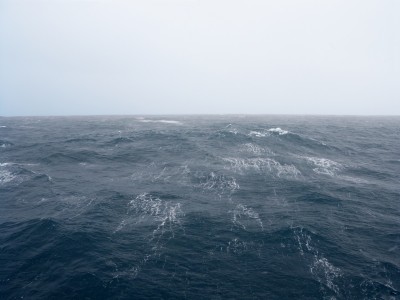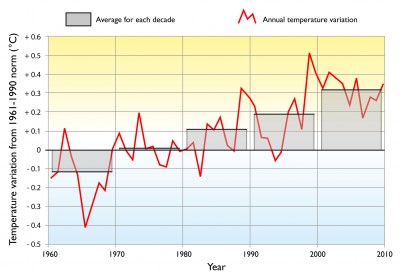The world ocean is the biggest heat store on the planet and a determining factor in global climate, yet we continue to overlook what’s happening there. [22 June 2010 | Peter Boyer]

Streaks of surface foam driven by high winds in the Southern Ocean, home of the world’s biggest ocean current and stormy engine-room of the global ocean.
We know a lot about the land that we live on, and have made a pretty fair fist of understanding other lands, including remote places like Antarctica and the surfaces of other heavenly bodies, illustrated by today’s astonishing array of computer-generated images.
Yet we seem to have a mental block when it comes to a particular part of our very own planet. We know precious little about the feature which makes Earth blue — the global ocean, covering two-thirds of the world’s surface.
Its scale is hard to take in. If all the world’s ocean waters were packed into a cube, each edge of the cube would be over 1100 kilometres long. Its average depth is 3.6 kilometres and its deepest point is nearly 11 kilometres down. Humans have explored only a tiny part of the ocean’s depths.
Of all Earth’s living space, only one per cent is on or near land surfaces; the rest is in the ocean — the cradle of all life, habitat for most species, and a major human food source. There are millions of microscopic organisms in a single mouthful of seawater. Life evolved in the sea three billion years before it emerged on to land, and it continues to evolve there.
Oceans dominate global weather and climate. Most of our rain comes from evaporated ocean waters, and the way heat is stored and transported in the oceans determines patterns of temperature and winds ashore. Changes to seawater, from the surface down to the deepest places, is a primary guide to both global temperature changes and the level of the waters lapping our shores.

The mean temperature at the surface of waters around Australia as recorded by the Bureau of Meteorology, showing a strongly rising trend in each decade since 1960
The temperature of sea surface waters is a major subject of study, involving large numbers of floating buoys sending signals by satellite to scientists ashore. Globally, sea surface waters are now warming at the rate of 0.6C per century, but waters around Australia, and especially to the east of Tasmania, are now getting a lot of scientific attention.
Over recent years tropical Australian waters have warmed at about double the global average rate of 0.6C per century. But waters of the south-west Tasman Sea — off the NSW south coast and eastern Tasmania — have been warming at an even faster rate, around three or four times the world average.
The warming is driven by a strengthening of the large East Australian Current, which has extended its reach from the latitude of Bass Strait southward, all the way to Maatsuyker Island and Port Davey.
The results are clear, and often devastating. Large expanses of sea-floor have been denuded of vegetation by invading species of sea urchins from NSW waters. The NSW giant rock barnacle has moved to Tasmania along with formerly alien fish and rock lobster species, and there are increasing occurrences of “red tides” — blooms of marine algae from tropical waters.
There are big implications here for Tasmanian wild fisheries. The abalone, scallops, rock lobster and numerous fish species that occur naturally around our island will have difficulty adapting to warming waters and competing with invading species. Aquaculture, too, may be affected. The reason our coastal bays and inlets shelter so many fish farms is that the species that have brought the state so many millions of export dollars prefer cold water.
The global ocean is also a big carbon store. A quarter of all the carbon we eject into the atmosphere when we burn fossil fuels is dissolved in the ocean. This extra ocean carbon is causing seawater to become slightly more acidic, enough to make life difficult for many animals and plants that live there, including shellfish and corals.
A recent Hobart meeting of international scientists discussed data collected from ships operating in the Southern Ocean with a view to mapping patterns of change in the ocean’s absorption of carbon dioxide.
CSIRO oceanographer Dr Bronte Tilbrook believes that a continuation of present carbon emission rates will see a pace of change in Southern Ocean chemistry in the next few decades that are unlikely to have been experienced for many millions of years.
Another international science meeting in Hobart last week looked at ocean waters below 2000 metres down, comprising more than half of total seawater volume. The workshop brought together research into the dynamics of this significant component of Earth’s climate system for the next Intergovernmental Panel on Climate Change report, due in 2013.
In these times of solo round-the-world yachting we might be tempted to think we know the ocean, but beneath those wind-blown surface waters are structures and processes that we’re just beginning to understand. Only in recent decades, for instance, have we come to appreciate the crucial importance of Antarctic ice and ocean processes in driving world ocean circulation.
These processes happen very slowly, over centuries or millennia. But we are discovering that in response to relatively rapid atmospheric changes caused by our fossil-fuel burning, the ocean can also change quickly, and the results will rarely be to our benefit.
• The role of biochar in profitably managing organic wastes while helping to reduce greenhouse emissions will be the subject of a workshop at the University of Tasmania School of Art, Hunter Street, Hobart, from 8.30am next Monday. For further information click here.
